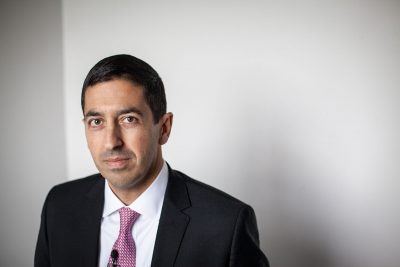To commemorate and acknowledge World AIDS Day, the Boston University School of Public Health hosted a panel Monday titled “Is Eradicating AIDS Feasible?” The panel featured speakers from various backgrounds who presented their views on the progress that has been made in AIDS research and the future for fighting the disease.

Sandro Galea, the dean of SPH, opened the event by remarking on the evolution of AIDS from being an untreatable disease to becoming manageable with new treatment options.
“Today AIDS has been transformed into a chronic disease, a disease that people live full and rich lives with within a normal lifespan,” Galea said in his opening remarks. “Now we are on the cusp of something even more exciting: the possibility of ending AIDS.”
Conditions that allow AIDS to persist — stigma, poverty, addiction and the marginalization of LGBT populations — must be addressed in order to eliminate AIDS worldwide, Galea wrote in an email.
“BUSPH has a long history of working on this topic,” Galea wrote. “This event was part of our effort to move the conversation in this direction.”
Robert Horsburgh, a professor of epidemiology at SPH who spoke at the event, said in an interview that it is important to think about ways to help those who don’t seek out help because they are embarrassed of the disease.
“I think we need to get the message out there,” Horsburgh said. “Removing the stigma is going to be the most important thing.”
Horsburgh said he moved into public health after caring for patients with AIDS, hoping to help prevent problems in future patients and “get the AIDS epidemic under control.”
“It was very frustrating seeing all the problems that could have been prevented but hadn’t been,” Horsburgh said. “I’m really into the prevention side, what we can do to prevent people and help them protect themselves.”
Inspired by Monday’s panel, Horsburgh said he is optimistic about the future of the fight against AIDS, noting the World Health Organization’s 90-90-90 plan.
“The goal is to get 90 percent of people who have HIV identified and get 90 percent of them into care and 90 percent of them virally suppressed,” Horsburgh said.
Jonathan Mermin, director of the National Center for HIV/AIDS, Viral Hepatitis, STD and TB Prevention at the CDC, and a rear admiral in the United States Public Health Service, delivered the keynote address at the event, broadening the focus of the discussion to also include HIV.
“Focusing only on AIDS, and not HIV, would miss much of the epidemic and part of the need,” Mermin said.
While a complete eradication of HIV is unlikely, Mermin said, it is possible to reduce its impact and occurrence in society to a nearly negligible level. He said he changed the question from “Is eradicating new HIV infections feasible?” to “Is eliminating new HIV infections feasible?”
“If we define elimination as fewer than one new infection per 100,000 persons … the answer is yes,” Mermin said. “It is an aspirational and achievable goal.”
The obstacles that are preventing a significant reduction of HIV are not purely scientific, Mermin said, but rather the culmination of many different aspects regarding the disease.
“Today, every death from HIV is preventable and each one highlights the failure of our public health, medical care, social and economic structures,” Mermin said. “The number of new HIV infections is greater than the number of people who die with HIV, a sign that we are continually doing better with treatment but a growing challenge for prevention.”
Panelist Helen Ayles, professor of infectious diseases and international health, and research director of the Zambart Project at the London School of Hygiene and Tropical Medicine, said in an interview that research on getting better treatments and longer-lasting prevention will benefit this public health issue.
“I do think that in the next 20 years we could,” Ayles said, “if we put in the necessary resources and the necessary effort get to a situation where we are seeing significantly fewer people becoming infected.”
Angela Dogani, a junior in the College of Fine Arts, said much of the stigma that surrounds the epidemic is due to ignorance.
“If we just reduce the ignorance around HIV and AIDS,” Dogani said, “then people who are possibly affected will actually start to seek the treatment that they rightfully deserve.”




















































































































